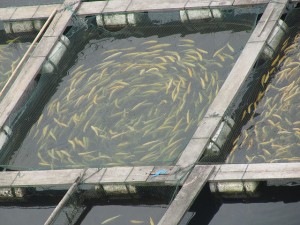Give a man a fish and he will have food for a day; teach a man industrial fish production and you can bring famine to his whole world. The latest illustration of that (relatively new) proverb comes from Maine, where raising salmon is threatening everything else.
Industrial salmon production, like all other industrial processes, achieves economy of scale and immediate profit by concentrating and delaying risk. Like cattle feed-lots, salmon pens make it easy to feed, harvest and ship tractor-trailer loads of fish (to compensate for the fact that industrial fishing has laid waste to the world’s wild fisheries), while concentrated deposits of fish feces and food waste degrade the waters all around. And as with all monoculture, the presence of an infinite number of prey draws an infinite number of predators. And parasites.
Thus the salmon pens of Maine (and everywhere else in the world), especially those in Passamaquoddy Bay, have lately been plagued by sea lice, in nearly infinite numbers. Like all good industrialists, Cook Aquaculture, operators of salmon farms in Maine and New Brunswick, Canada, responded with chemical warfare, drenching their fish with a pesticide called cypermethrin. Among others. [Details were reported last week by the Bangor Daily News.]
Cypermethrin kills crustaceans. Sea lice are crustaceans. So are lobsters. Big as the salmon industry is in Maine (nearly $40 million in state revenue) the lobster industry is bigger. Six times bigger. And the lobstermen, er, people, are upset. The Canadian government is investigating lobster kills that occurred just across the border from Maine in 2009 and 2010. And US lobster people remember when, ten years ago, a pesticide used to kill mosquitoes nearly obliterated the lobster population of Long Island Sound. But they are sympathetic. Patrice McCarron, executive director of the Maine Lobstermen’s Association, is quoted as saying, “We have to find the right balance of sharing the ocean so industries can coexist.” Right. It’s the industrial ecosystem that matters.
One of the reasons the sea lice were particularly bad this past year is that warmer winters in Maine have failed to kill off the sea lice population as always happened before the climate started changing. Another reason: the little critters are becoming resistant to cypermethrin, in the same way that all little organisms evolve when drenched with chemicals. One of the effects of the burgeoining population of lice in the salmon pens is that they spread way beyond the pens to the diminished population of wild fish.
Among all industrial food processes, salmon raising (never, never call it farming. Please.) is especially noxious. It requires three pounds of small fish, processed as feed for the salmon, to produce a pound of salmon (which concentrates in the salmon such compounds as mercury). Salmon feces and waste feed under the pens contaminate the water, produce algae blooms, deplete oxygen and kill sea life. Seals, sea lions, porpoises and dolphins drawn to the salmon pens become snared in the nets and die. Genetically engineered salmon regularly escape into the wild, with unknown consequences for the web of life.
Such concerns led Britain’s fisheries minister, Richard Benyon, last week to question the sustainability of salmon production and to suggest that consumers consider switching to less trendy wild fish species such as gurnard or megrim, that can be supplied by, you know, fishing.
But in the US it remains business as usual, as the search goes on for ways to create a smarter planet, where industries can coexist.
